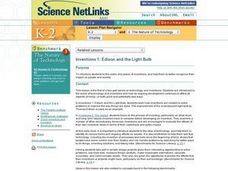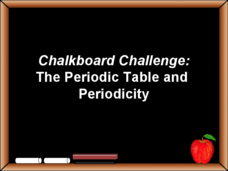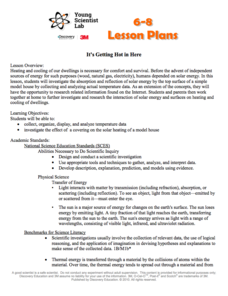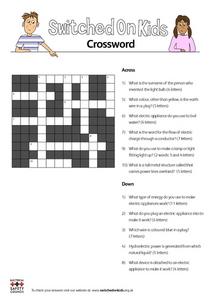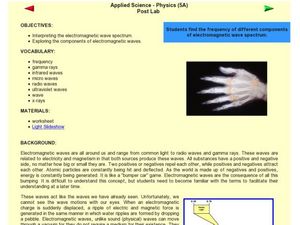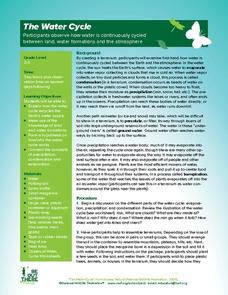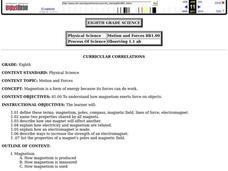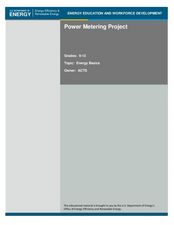Curated OER
Inventions 1: Edison And The Light Bulb
Students examine the realm and power of inventions, and recognize their impact on people and society. Small groups pretend to have been hired by Edison to make special posters that advertise the uses and benefits of the light bulb.
Curated OER
Chalkboard Challenge: The Periodic Table and Periodicity
In a well-prepared Jeopardy-style game, your chemisty class can review the periodic table. Questions cover the element groups, some history, atomic number, atomic and ionic radii, electronegativity, and the shielding effect. What a fun...
It's About Time
Renewable Energy Sources - Solar and Wind
There has been a huge solar energy spill! Let's go outside to play in it. This lesson includes multiple experiments showcasing solar and wind energies. Scholars build a solar heater and an anemometer before testing the results. The...
Curated OER
Real-World Applications to Imaginary and Complex Numbers
Authenticate imaginary numbers through real-life applications in science, math, and literature.
Discovery Education
It's Getting Hot in Here
Class members engage in a STEM experiment and investigate how materials affect heating in a house by creating models of houses and using different top surface materials. They record the temperature inside the models and consider what the...
Curated OER
Transformation of Energy-8th Grade
Eighth graders examine how electricity is produced in relation to the atom as well as what causes electric current to flow and what determines how much current flows through a circuit. These and other concepts of transformation of energy...
Curated OER
Generators: Three Mile Island vs. Hoover Dam
Students are given a history of electricity and its development into the modern age lifeline upon which we so depend. The methods of power generation are introduced, and further discussion of each technology's pros and cons follows. ...
Curated OER
Electromagnitism Applications
Students experiment on magnets and electricity. In this physics lesson, students determine what factors affect the strength of a magnetic field. They design an experiment to determine how electromagnetic field strength varies with distance.
Curated OER
History of the Battery
Students study the development of batteries. In this electrochemistry lesson, students compare the different types of batteries. They explore its applications especially in the medical field.
Curated OER
On The Move
Fourth graders solve basic mathematical problems. They identify and apply key terms and equations relative to physical science. They discuss how train engines use fuel to move a generator, which creates electrical current that moves...
Curated OER
Switched on Kids Crossword
In this electricity and energy activity, students fill in a crossword puzzle as they figure out the answers to 11 clues involving science terminology.
Curated OER
Experiments with Photovoltaic Cells
Students explain how sunlight is converted to electricity. In this series of physics lesson, students study how varying the characteristics of the light source affect photovoltaic cells. They research their different uses in other...
Curated OER
Who Turned on the Lights?
Seventh graders discuss how energy is transformed from one form to another. In this physics lesson, 7th graders design and build their own hydro generator. They identify the factors that affect its energy production.
Curated OER
Are you an Energy Saver STAR?
Young scholars examine how to use energy more efficiently in their own home. They collect data from their home, complete a chart, read a power meter, interpret the data from an electric and gas bill, and create a poster demonstrating how...
Curated OER
Poster Presentations
Students create visual displays explaining how nuclear power is used to produce electricity. They create a display board that shows the chain reaction, the fission process, and a schematic diagram of the reactor.
Curated OER
Electromagnetic Wave Spectrum
Fifth graders examine electromagnetic wave spectrum. In this science instructional activity, 5th graders discuss the aspects of the electromagnetic wave spectrum and complete a worksheet identifying the parts of the spectrum.
Curated OER
The Water Cycle
Learners are introduced to the components and importance of the water cycle. They are shown how groundwater moves using a model. Students list 9 places on earth where water is found. They define the terms cycle and water cycle.
Curated OER
100 Years of Flight
Students investigate Bernoulli's principle of air pressure and how it
relates to the lift of an airplane. Students identify various Aeronautical vocabulary terms. Students construct a paper glider and experiment with the control surfaces...
Curated OER
Energy Efficiency at Home: An Interdisciplinary Module for Energy Education
Students examine energy efficiency and how they use energy at home. In this energy conservation instructional activity students complete several science activities that give students a better understanding of energy.
Curated OER
Motion and Forces
Eighth graders define the terms: magnetism, poles, compass, magnetic field, lines of force, electromagnet. They name two properties shared by all magnets and describe how one magnet will affect another.
Curated OER
The Nervous System from A to Z
In this nervous system alphabet book learning exercise, students study 26 neuroscience terms as they read the 26 terms and their definitions in the glossary. Some of the terms included are: receptor, unipolar, white matter, axon,...
Curated OER
Physics and the Quantum Mechanical Model
For this physics worksheet, students review vocabulary terms and key equations associated with the quantum mechanical model. Students apply the quantum theory to explain the photoelectric effect. This worksheet has 5 true or false, 12...
Curated OER
Power Metering Project
High schoolers collect and analyze variable data and understand the concept of electrical power. In this energy lesson students use a spreadsheet to manage their data and create box plots.
Curated OER
Vibrant Volcanoes
Students explore volcanoes. In this science lesson plan, students discuss the characteristics of volcanoes and view a video segment about a volcano. Students examine plate tectonics.


